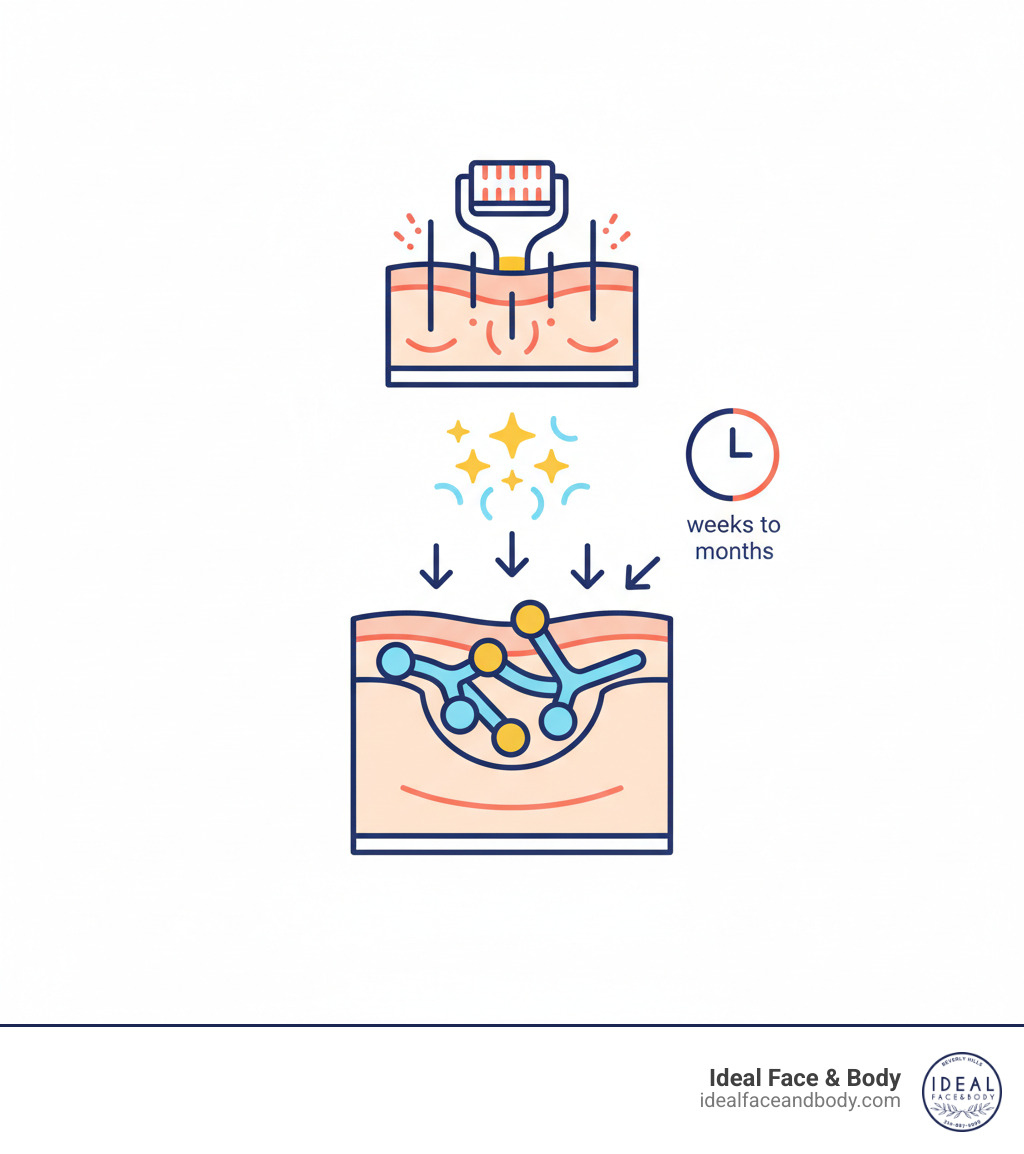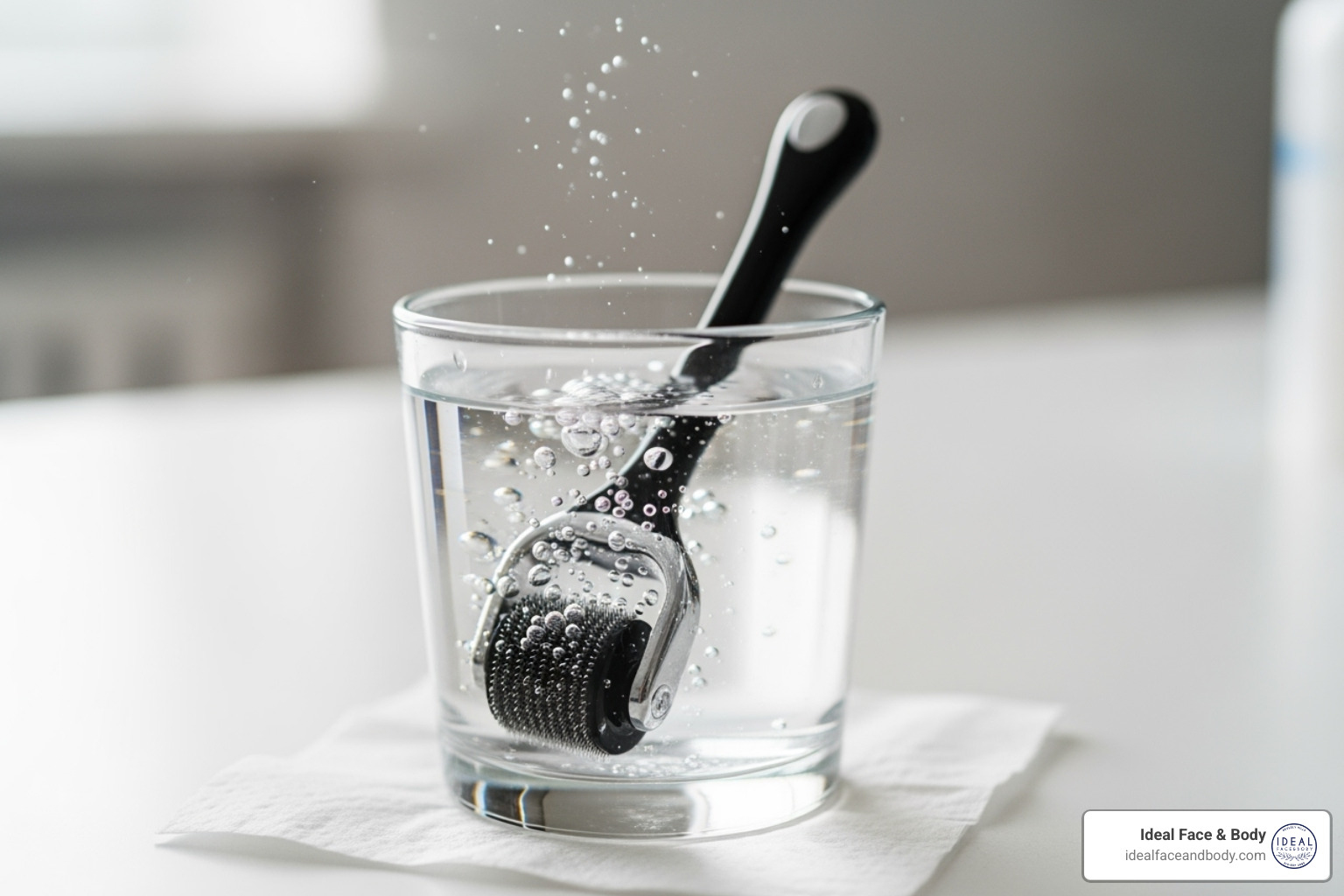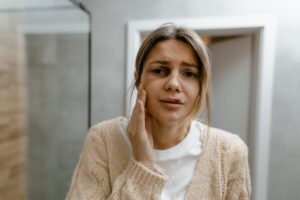Derma Roller for Pimple Marks: #1 Flawless Skin
Understanding Pimple Marks and Your Treatment Options
Derma roller for pimple marks is a popular at-home treatment that uses tiny needles to stimulate collagen production and fade post-acne scarring. Here’s what you need to know:
- Best for depressed scars: Works effectively on ice pick, boxcar, and rolling scars
- Needle length matters: 0.5mm for hyperpigmentation, 1.0mm for shallow scars, 1.5mm for deeper scars
- Results take time: Expect gradual improvement over several months with consistent use
- Not for active acne: Wait until breakouts heal completely before rolling
- Professional treatments offer deeper penetration: Clinical microneedling reaches 2-3mm vs. 0.25-1.5mm at home
Acne is frustrating enough, but the marks it leaves behind can linger for months or years, affecting your confidence. The good news is that dermarolling—also called microneedling or collagen induction therapy—is an accessible way to address these concerns. The treatment creates controlled micro-injuries in your skin, triggering your body’s natural healing response to produce new collagen and elastin. This process helps smooth out depressed scars and even out skin tone over time.
Research shows that microneedling can improve acne scars by 50-70%, especially when combined with treatments like platelet-rich plasma (PRP). The procedure is considered safe for all skin tones, including darker complexions that may be at higher risk for complications with other treatments.
However, at-home dermarolling has limitations. While it can help with superficial concerns, it can’t penetrate as deeply as professional equipment. The FDA hasn’t approved any microneedling devices for over-the-counter sale, and improper use can lead to infection or scarring.
I’m Dr. Sarah Yovino, a double board-certified physician at Ideal Face & Body in Beverly Hills. With years of experience in advanced derma roller for pimple marks treatments, I’ve helped countless patients achieve smoother skin. Understanding how this treatment works is the first step toward making an informed decision, whether you’re considering an at-home approach or exploring professional options.
The Science: How Dermarolling Fades Scars and Marks
Using a derma roller for pimple marks works through a process of controlled skin injury. The fine needles create micro-channels in your skin, which your body recognizes as injuries and immediately begins to repair. This triggers collagen induction therapy, a natural healing cascade that produces fresh collagen and elastin—the proteins that give skin its firmness and structure. Since scar tissue lacks these proteins, this process remodels your skin from the inside out.
Crucially, microneedling works best for depressed scars. These atrophic scars appear as indentations. The American Academy of Dermatology confirms that microneedling’s collagen-boosting effects help fill in these depressions. However, it is not recommended for raised (hypertrophic and keloid) scars, as stimulating more collagen could make them worse.
For a comprehensive look at how this treatment addresses different scar types, you can explore our guide on Microneedling for Scar Treatment.
What Types of Pimple Marks Can a Derma Roller Treat?
Understanding which marks respond to dermarolling helps set realistic expectations. A derma roller for pimple marks can improve the following:
- Ice pick scars: These deep, narrow puncture marks are stubborn. Microneedling can stimulate collagen around their edges, making them less noticeable over time.
- Boxcar scars: These wider depressions with sharp edges respond well to microneedling. The new collagen helps lift the depressed area and smooth the edges. Learn more on our page about Microneedling Boxcar Scars.
- Rolling scars: These create a wavy, uneven texture. Microneedling helps by breaking up the fibrous bands pulling the skin down and stimulating new collagen to lift the surface.
- Post-inflammatory hyperpigmentation (PIH): These are the dark spots left after inflammation. Dermarolling accelerates skin cell turnover, replacing pigmented cells with fresh, evenly toned skin.
Warning: Never use a derma roller on keloid or raised scars, as it can worsen them. Also, avoid rolling over active breakouts, psoriasis, or eczema, as this can spread bacteria and cause more inflammation.
How Does It Work on a Cellular Level?
The real magic happens beneath the surface through a process called neocollagenesis (new collagen creation).
When the needles puncture the skin, your body releases growth factors that signal for repair. This activates fibroblasts, the cells that produce collagen and elastin. They begin synthesizing a new structural matrix for your skin.
Simultaneously, the micro-injuries help break down old, disorganized scar tissue. As this rigid framework is dismantled, the fresh, new collagen can integrate more smoothly, creating a more uniform skin texture.
Over the following weeks and months, this continuous regeneration results in thicker, firmer, and smoother skin with less visible scarring. This healing cascade is why microneedling is effective for so many skin concerns. For more on the science, this scientific review of microneedling applications offers deeper insights.
Your At-Home Guide to Using a Derma Roller for Pimple Marks
Using a derma roller for pimple marks at home can be effective, but only if done correctly and with meticulous hygiene. It offers convenience and is more budget-friendly than professional treatments, but it requires your full attention.
Before rolling, your skin must be completely clean. Afterward, your skin is primed to absorb nourishing serums. Most importantly, sunscreen becomes non-negotiable after treatment, as your skin will be more vulnerable to sun damage.
Choosing the Right Needle Size for Pimple Marks
Using the wrong needle size is a common mistake. Needles that are too long can cause trauma, while needles that are too short won’t be effective. For at-home use, stay within the 0.25mm to 1.5mm range. Anything longer should be left to professionals.
- 0.25mm to 0.5mm: Ideal for post-inflammatory hyperpigmentation (dark spots) and enhancing serum absorption. Can be used 1-3 times per week.
- 1.0mm: Targets shallow acne scars, fine lines, and enlarged pores. Use every 10-14 days to allow for adequate skin recovery.
- 1.5mm: Best for deeper boxcar or rolling scars. Due to the deeper penetration, use only every 3-4 weeks to allow for complete collagen remodeling.
Research on needle depth for acne scars confirms that matching needle length to your concern yields the best results. The table below provides a quick reference.
| Needle Length (mm) | Target Concern | Recommended At-Home Frequency |
|---|---|---|
| 0.25 – 0.5 | Post-Inflammatory Hyperpigmentation (PIH), uneven skin tone, improved product absorption | 1-3 times a week (0.25mm can be every other day) |
| 1.0 | Shallow acne scars, fine lines, light wrinkles, larger pores | Every 10-14 days |
| 1.5 | Deeper acne scars (boxcar, rolling), moderate wrinkles, stretch marks | Every 3-4 weeks |
Step-by-Step: The Proper Rolling Technique
Follow this methodical approach for safe and effective at-home use of a derma roller for pimple marks.
- Cleanse: Wash your face with a gentle, pH-balanced cleanser and pat dry.
- Disinfect: Submerge the roller head in 70% isopropyl alcohol for 5-10 minutes. This step is mandatory to prevent infection.
- Numb (Optional): For needles 1.0mm or longer, you can apply a topical numbing cream 20-30 minutes prior. Wipe it off completely before rolling.
- Roll: Work in sections (forehead, cheeks, chin). Gently stretch the skin. Roll over one small area 4-6 times in one direction (e.g., vertically), lifting the roller off the skin after each pass. Do not drag it. Repeat horizontally and then diagonally. Apply gentle pressure; pinpoint bleeding is normal with longer needles, but heavy bleeding means you’re pressing too hard.
- Avoid: Never roll over active breakouts, open sores, or inflamed skin. This can spread bacteria and worsen scarring.
- Soothe: Rinse your face with cool water and immediately apply a gentle, hydrating serum with ingredients like hyaluronic acid or peptides. Avoid retinoids or strong exfoliants for a few days.
- Protect: Apply a broad-spectrum sunscreen (SPF 30+) every morning after treatment.
- Clean Again: Disinfect your roller with alcohol, let it air dry completely, and store it in its protective case.
Consistency and patience are key to seeing results. For more insights, explore our resources on Skin Rejuvenation.
Essential Cleaning and Maintenance for Your Roller
If you are not willing to properly clean your derma roller, you should not use one. A dirty roller is dangerous and can lead to infection, new breakouts, or worse scarring.
- Disinfect Before and After: Soak the roller head in 70% isopropyl alcohol for 5-10 minutes before and after every use. Soaking is more effective than spraying.
- Rinse (Optional): After disinfection, you can rinse the roller under warm water to remove any debris, then let it air dry.
- Air Dry: Place the roller on a clean paper towel to dry completely. Do not use a cloth towel, which can harbor bacteria and lint.
- Store Safely: Once completely dry, return the roller to its protective case to prevent damage and contamination.
- Replace Regularly: Derma rollers are not permanent. Replace yours after 10-15 uses, or sooner if you see any bent or damaged needles. Dull needles can tear the skin.
Following these cleaning protocols is the foundation of safe at-home microneedling. For more on disinfection, you can refer to the CDC guidelines on disinfection.
Safety, Expectations, and Professional Alternatives
Using a derma roller for pimple marks requires realistic expectations and an understanding of the risks. While at-home microneedling can offer improvements, it’s not a magic wand.
After rolling, expect some redness (like a mild sunburn), mild swelling, and sun sensitivity. These effects are normal and usually fade within a day or two. Diligent use of broad-spectrum sunscreen (SPF 30+) is non-negotiable to prevent hyperpigmentation.
The most serious risk is infection. By creating micro-channels in your skin, you temporarily compromise its protective barrier. Using an unsterile roller or rolling over active acne can introduce bacteria, leading to inflammation and more scarring.
If you experience prolonged redness, increasing pain, or signs of infection, stop using the roller and consult a professional. Our team at Ideal Face & Body in Beverly Hills offers advanced Non-Surgical Facial Rejuvenation treatments custom to your needs.
Potential Risks and Who Should Avoid Dermarolling
Using a derma roller for pimple marks can be harmful in certain situations. You should avoid it if you have:
- Active acne, skin infections, or cold sores: Rolling can spread bacteria and worsen inflammation.
- Inflammatory skin conditions: Eczema, psoriasis, or rosacea can be triggered by microneedling.
- A history of keloid scarring: Microneedling stimulates collagen, which could trigger the overgrowth of scar tissue.
- Certain medical conditions or medications: If you take blood thinners, immunosuppressants, or have used isotretinoin (Accutane) in the last 6-12 months, avoid microneedling. It is also not recommended during pregnancy or for those with a compromised immune system.
- Recent sunburn or a history of skin cancer in the treatment area.
The FDA warns about microneedling risks, noting that at-home devices are not approved for medical use and carry risks. When in doubt, consult a board-certified physician like Dr. Sarah Yovino or Dr. Justin Yovino.
What Results Can I Expect for Pimple Marks, and How Soon?
Using a derma roller for pimple marks is a marathon, not a sprint. Improvements are gradual as your skin slowly rebuilds collagen over weeks and months.
The collagen remodeling timeline requires patience. It takes several weeks for new collagen to form, which is why treatments are spaced apart. For moderate acne scars, you will likely need three to four sessions to see significant improvement, though more severe scarring may require more.
While some people notice a glow or smoother texture within a few weeks, it can take up to one year to see the full, optimal results. Consistency is your best friend. Sticking to a proper schedule and aftercare routine is crucial for success. Your skin type, the severity of your scars, and your overall health will all influence your results. For a visual guide, see our Microneedling Before and After Scars page.
At-Home vs. Professional Microneedling
While at-home derma roller for pimple marks has its place, it’s important to understand the significant advantages of professional microneedling.
- Needle Depth: At-home rollers (0.25-1.5mm) are limited to surface-level treatment. Professional devices can safely penetrate up to 3mm, reaching the deeper layers of the dermis for true structural remodeling of scars.
- Sterility and Safety: A clinical setting provides medical-grade sterilization, drastically minimizing the risk of infection compared to at-home cleaning.
- Advanced Technology: Professionals use motorized pens or radiofrequency (RF) microneedling devices. These offer precise, adjustable depth and a vertical stamping motion that reduces the risk of skin tearing. RF microneedling also adds heat to amplify collagen production.
- Improved Treatments: In a professional setting, microneedling can be combined with Platelet-Rich Plasma (PRP). Using your own blood’s growth factors, a PRP Facial can boost results, leading to 50-70% fading of acne scars.
- Expert Customization: A professional assesses your unique skin and scar type to create a personalized, safe, and effective treatment plan. They can also combine microneedling with other treatments like Laser Skin Resurfacing for comprehensive results.
For noticeable, safe, and lasting improvement of acne scars, professional microneedling is the gold standard.
Frequently Asked Questions about Dermarolling
Navigating derma roller for pimple marks can bring up questions. Here are some quick answers to common curiosities.
How often should I use a derma roller for pimple marks?
Frequency depends on needle length and your skin’s recovery. Giving your skin time to heal is as important as consistency.
- 0.25mm – 0.5mm needles: Can be used 1-3 times per week for mild concerns like hyperpigmentation and product absorption.
- 1.0mm needles: Use every 10-14 days for shallow acne scars.
- 1.5mm needles: Use every 3-4 weeks for deeper scars to allow for full collagen remodeling.
Always listen to your skin. If you experience prolonged irritation, increase the time between sessions.
Does dermarolling hurt?
The sensation varies by needle length and your pain tolerance.
- Shorter needles (0.25mm – 0.5mm): Most people feel a light prickling or tingling sensation, which is generally well-tolerated.
- Longer needles (1.0mm – 1.5mm): The sensation is more intense. A topical numbing cream applied 20-30 minutes beforehand is highly recommended to reduce discomfort.
While some discomfort is expected, it should not be severely painful. If it is, you may be applying too much pressure.
Can I use a derma roller on active pimples?
No, absolutely not. Using a derma roller for pimple marks on active breakouts is one of the biggest mistakes you can make.
- It spreads bacteria: Needles can pick up bacteria from a pimple and distribute it across your face, causing more breakouts.
- It worsens inflammation: Rolling over inflamed skin increases irritation and can lead to more severe scarring.
- It increases infection risk: Puncturing active lesions creates open wounds that are highly susceptible to infection.
Always wait until breakouts have completely healed before you consider rolling.
Your Next Step Towards Clearer Skin
We’ve covered the science, technique, and safety of using a derma roller for pimple marks. You now have the foundation to make smart decisions for your skin.
To summarize, dermarolling is a useful tool for atrophic (depressed) scars, but it is not a quick fix. The process of rebuilding collagen is gradual, unfolding over months. Safety, hygiene, and proper technique are non-negotiable to prevent infection and complications. And remember, never roll over active breakouts.
While at-home rolling can help with superficial issues, professional guidance yields superior results. The advanced microneedling treatments at Ideal Face & Body in Beverly Hills penetrate deeper, are performed in a sterile environment, and can be combined with powerful therapies like PRP to dramatically improve scars. Dr. Sarah Yovino and Dr. Justin Yovino specialize in creating personalized plans to help patients achieve their skin goals safely and effectively.
Your journey to clearer skin doesn’t have to be a solo one. If you’re ready to see what professional microneedling can do for you, we invite you to explore professional treatments for scars. Let our team guide you toward the radiant complexion you deserve.








